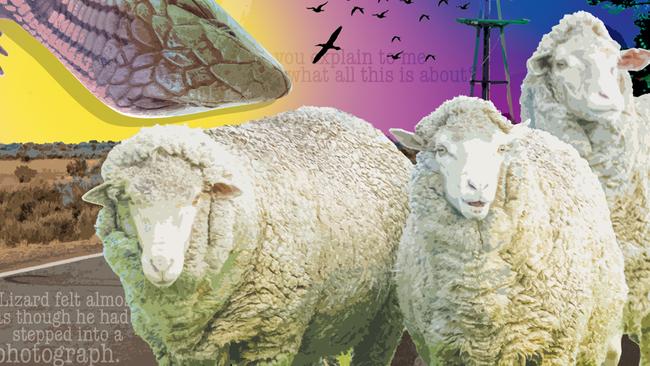Lonely Gully: Chapter 4
Gideon Haigh lifts the lid on Lizard Blair’s mystery crate and uncovers a surprise occupant as shearing mate Furtle Burley arrives at the scene holding a strange device.

The Australian’s summer novel is back. Our star writers – and a few special guests – join forces for a progressive story, Lonely Gully, after the smash-hit success of last year's Oh Matilda: Who Bloody Killed Her.
Each writer gets just three days to take the story forward, with complete freedom over plot and character, before the grand finale on January 15.
Today, Gideon Haigh takes up the story.
-
By Gideon Haigh
It would not be right to say that Lizard has never seen anything like it before; in fact, quite the opposite is true. His life’s been full of them. He knows them intimately. Many do. Even those who lack a direct acquaintance are accustomed to counting such quadrupedal ruminants in order to sleep. Because, large as life and twice as billowy, before him stands a sheep.
Except it is not … quite … right. All the other sheep of Lizard’s extensive experience have been either visibly mobile, writhing beneath his questing shears, or limp, ailing and even deceased. This is an ovine adonis. Its brow is noble, its facial lineaments classic. It’s whiter than a coalition front bench. So thick is the fleece, it’s as though the creature is enveloped in a giant afro. Except that it stands entirely, eerily, still; stiller than Nicole Kidman’s face; stiffer than Tim Paine before the 2017 Gabba Test.
Stepping gingerly into the crate on the back of the Kenworth, Lizard starts edging round the sheep. Is it a statue or idol? Is it a model or an exhibit? He has seen taxidermy and never found it convincing. If you’ve experience of animals, taxidermy looks as approximate as a Mona Lisa rendered in HB pencil.
This is something more, somehow uncanny. Even in its inanimation, this sheep radiates authority, even charisma. The eyes shine, the haunches are muscular, the cloven hooves perfectly trimmed. Lizard hesitantly extends a hand, and brushes against the crimped superfine wool; it feels superbly natural, gossamer-like but with an underlying tensile strength. It seems bizarre that something so lifelike could be so devoid of motion. Lizard feels almost as though he has stepped into a photograph.
Lizard learned the characteristics of the elite ungulate at the knee of his shearing shed mentor Furtle Burey, whom he encountered on his first day, as a callow 15-year-old, at Lonely Gully.
Furtle, of an indeterminate age anywhere between 40 and 70, appeared to have stepped straight from Shearing the Rams, and to be possessed of the wisdom of the ages. He did not shear sheep so much as unzip their fleeces. If he did not actually baaa, his voice had a guttural vibrato that suggested he was almost part merino. On the subject of sheep, this otherwise inscrutable man scaled peaks of eloquence.
‘The thing about sheep is that they’ve had a bad press,’ Furtle would say. ‘They’re smart. They problem-solve. They display emotions. They recognise faces. They have a 300-degree field of vision and a memory that can encompass as many as fifty individuals. They move in flocks, but so do we, and at least sheep aren’t drawn to Trump rallies, Marvel movies, Nickelback concerts. Nothing moves a sheep save food and fear. There’s a spiritual simplicity to that.
‘Yet where are our sheep heroes? You’ve got your Lassie and your Toto, your Black Beauty and your Friend Flicka, your Peppa and your Miss Piggy, your Templeton and your Reepicheep. But your genus Ovis? Beatrix Potter’s obsessive anthropomorphism doesn’t yield so much as a lamb; where’s the woolly Watership Down? Even where we get a mention, it’s derisive. The little lamb just follows Mary round. The assumption is that Little Bo Peep’s sheep will just come back whenever. And don’t get me started on Animal Farm.’
Nobody would make that mistake here, thinks Lizard. This is an ur-sheep, a kind of bovidean platonic ideal. Had it been running for office, you’d have voted for it. Had it been on Tinder, you’d have swiped right.
Now, though, Lizard becomes aware of another presence, that this stretch of deserted road is no longer so deserted. In the distance, he sees what he gradually recognises as, yes, an off-white Hilux – the kind of vehicle he’s been advised by Tamara Meadows to await by the Hillgrove Road turn-off.
What now? Should he take to his heels? No, he still has Button’s service revolver; besides, Lizard fancies he can handle himself, and if he was not prepared to delve more deeply into this swirling mystery would never find his way to Deb.
Something about the Hilux, too, is familiar. Vans can be like that. They have a oneness. They are space on wheels. Their presence is benign, their approach is lulling. There are car chases but no van chases; there are truckies but no vannies. So Lizard stands his ground, while the sheep cannot do otherwise, as the vehicle approaches, and pulls into the verge on the far side of the Kenworth. Lizard tightens his hand round the gun, then feels his grip loosen as he recognises the figure stepping from the driver’s cabin. It is … Furtle himself.
Again, however, here is something familiar in a completely new guise. Lizard’s never seen Furtle in anything but a shearing shed ensemble of dungarees and Blundstones. Now towards the Kenworth comes a completely new Furtle – expressionless, absorbed, and clad in crisply-laundered khaki. Briefly their eyes meet. ‘Furtle?’ says Lizard cautiously. As he brushes past, Furtle’s lips barely move: ‘G’day Lizard.’
‘Can you explain to me what all this is about?’ Lizard ventures at last.
Furtle’s focus is elsewhere. In one hand he holds an iPhone, in the other a device that resembles a television’s remote control. Having stepped past Lizard, he is gazing intently into the open crate.
‘What’s going on, Furtle?’ says Lizard insistently. ‘What have I walked into? Where’s Deb? What’s Button up to?’ Instead of answering, Furtle aims the mystery device in his hand at the stationary sheep – and presently, before Lizard’s astonished eye, like a bride stepping from her negligee on wedding night, the extraordinary animal sheds its luxuriant fleece, and stands in its crate, as it were, nude. A tight smile of satisfaction crosses Furtle’s previously impassive features. Just then, his iPhone emits a sharp, electronic bleat.
Furtle holds it to his ear. ‘Yes,’ he says. ‘It’s here.’
Gideon Haigh has been a journalist for 38 years, published more than 40 books and contributed to more than 100 newspapers and magazines. He is the co-host of The Australian’s podcast Cricket, Et Cetera with fellow writer Peter Lalor and is glad he doesn’t need to finish what he’s started.
COMING UP: On Thursday Susan Kurosawa continues the story with Chapter 5, followed by Cameron Stewart on Friday.
Read every chapter in the paper, on The Australian’s app and at lonelygully.com.au



To join the conversation, please log in. Don't have an account? Register
Join the conversation, you are commenting as Logout